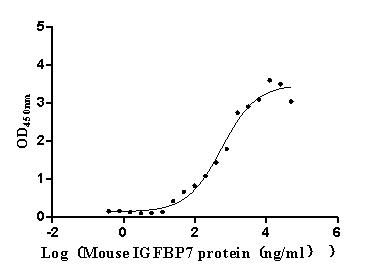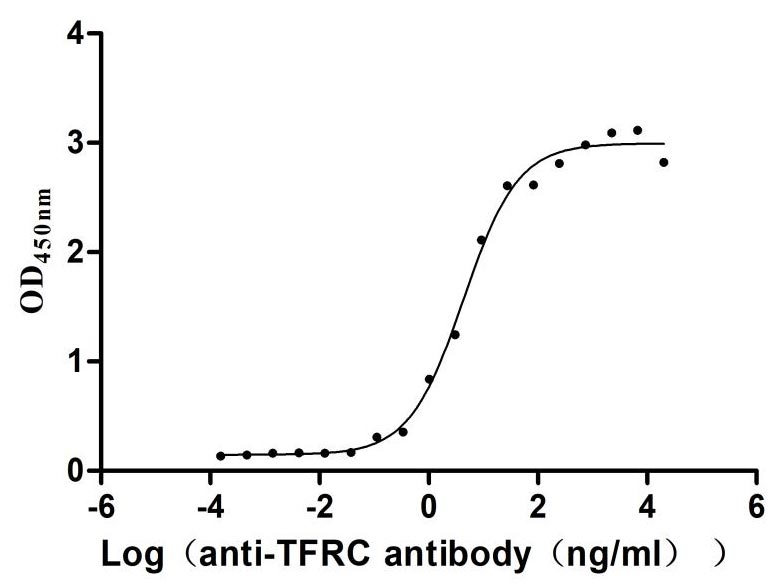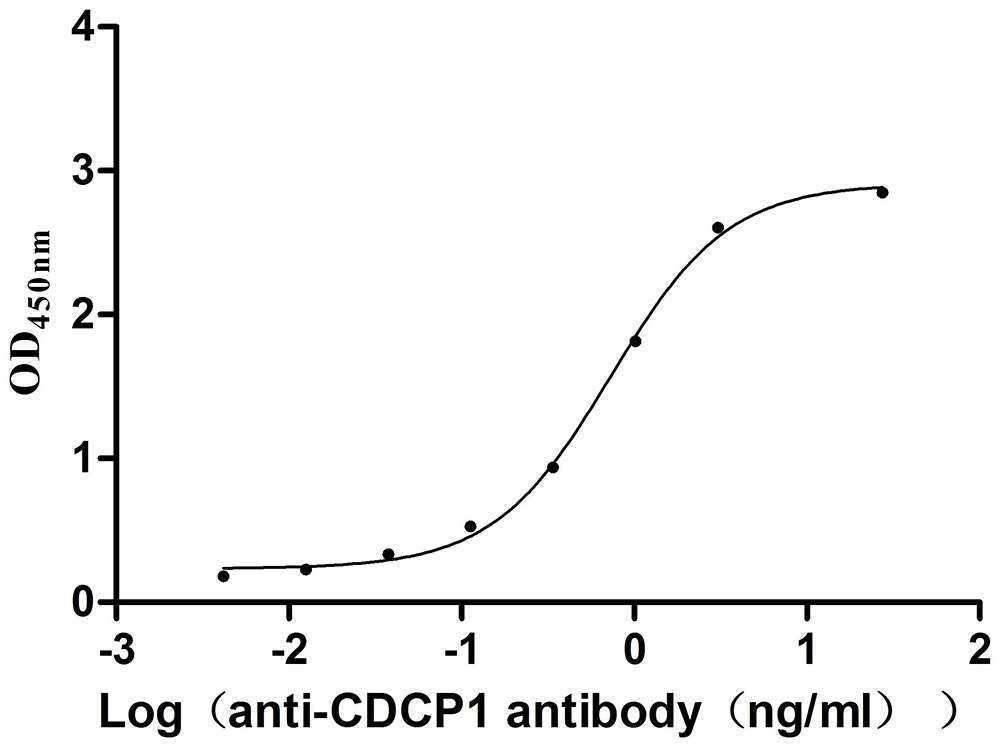Recombinant Hepatitis B virus genotype A1 subtype adw Capsid protein (C)
-
中文名稱:Recombinant Hepatitis B virus genotype A1 subtype adw Capsid protein(C),Yeast
-
貨號(hào):CSB-YP313676HDK
-
規(guī)格:
-
來源:Yeast
-
其他:
-
中文名稱:Recombinant Hepatitis B virus genotype A1 subtype adw Capsid protein(C),Yeast
-
貨號(hào):CSB-EP313676HDK
-
規(guī)格:
-
來源:E.coli
-
其他:
-
中文名稱:Recombinant Hepatitis B virus genotype A1 subtype adw Capsid protein(C),Yeast
-
貨號(hào):CSB-EP313676HDK-B
-
規(guī)格:
-
來源:E.coli
-
共軛:Avi-tag Biotinylated
E. coli biotin ligase (BirA) is highly specific in covalently attaching biotin to the 15 amino acid AviTag peptide. This recombinant protein was biotinylated in vivo by AviTag-BirA technology, which method is BriA catalyzes amide linkage between the biotin and the specific lysine of the AviTag.
-
其他:
-
中文名稱:Recombinant Hepatitis B virus genotype A1 subtype adw Capsid protein(C),Yeast
-
貨號(hào):CSB-BP313676HDK
-
規(guī)格:
-
來源:Baculovirus
-
其他:
-
中文名稱:Recombinant Hepatitis B virus genotype A1 subtype adw Capsid protein(C),Yeast
-
貨號(hào):CSB-MP313676HDK
-
規(guī)格:
-
來源:Mammalian cell
-
其他:
產(chǎn)品詳情
-
純度:>85% (SDS-PAGE)
-
基因名:C
-
Uniprot No.:
-
別名:C; Capsid protein; Core antigen; Core protein; HBcAg; p21.5
-
種屬:Hepatitis B virus genotype A1 subtype adw (isolate Philippines/pFDW294/1988) (HBV-A)
-
蛋白長(zhǎng)度:full length protein
-
表達(dá)區(qū)域:1-185
-
氨基酸序列MDIDPYKEFG ATVELLSFLP SDFFPSVRDL XDTASALYRE ALESPEHCSP HHTALRQAIL CWGKLMTLAT WVGNNLEDPA SRDLVVNYVN TNMGLKIRQL LWFHISCLTF GRETVLEYLV SFGVWIRTPP AYRPPNAPIL STLPETTVVR RRDRGRSPRR RTPSPRRRRS QSPRRRRSQS RESQC
-
蛋白標(biāo)簽:Tag?type?will?be?determined?during?the?manufacturing?process.
The tag type will be determined during production process. If you have specified tag type, please tell us and we will develop the specified tag preferentially. -
產(chǎn)品提供形式:Lyophilized powder
Note: We will preferentially ship the format that we have in stock, however, if you have any special requirement for the format, please remark your requirement when placing the order, we will prepare according to your demand. -
復(fù)溶:We recommend that this vial be briefly centrifuged prior to opening to bring the contents to the bottom. Please reconstitute protein in deionized sterile water to a concentration of 0.1-1.0 mg/mL.We recommend to add 5-50% of glycerol (final concentration) and aliquot for long-term storage at -20℃/-80℃. Our default final concentration of glycerol is 50%. Customers could use it as reference.
-
儲(chǔ)存條件:Store at -20°C/-80°C upon receipt, aliquoting is necessary for mutiple use. Avoid repeated freeze-thaw cycles.
-
保質(zhì)期:The shelf life is related to many factors, storage state, buffer ingredients, storage temperature and the stability of the protein itself.
Generally, the shelf life of liquid form is 6 months at -20°C/-80°C. The shelf life of lyophilized form is 12 months at -20°C/-80°C. -
貨期:Delivery time may differ from different purchasing way or location, please kindly consult your local distributors for specific delivery time.Note: All of our proteins are default shipped with normal blue ice packs, if you request to ship with dry ice, please communicate with us in advance and extra fees will be charged.
-
注意事項(xiàng):Repeated freezing and thawing is not recommended. Store working aliquots at 4°C for up to one week.
-
Datasheet :Please contact us to get it.
靶點(diǎn)詳情
-
功能:Self assembles to form an icosahedral capsid. Most capsids appear to be large particles with an icosahedral symmetry of T=4 and consist of 240 copies of capsid protein, though a fraction forms smaller T=3 particles consisting of 180 capsid proteins. Entering capsids are transported along microtubules to the nucleus. Phosphorylation of the capsid is thought to induce exposure of nuclear localization signal in the C-terminal portion of the capsid protein that allows binding to the nuclear pore complex via the importin (karyopherin-) alpha and beta. Capsids are imported in intact form through the nuclear pore into the nuclear basket, where it probably binds NUP153. Only capsids that contain the mature viral genome can release the viral DNA and capsid protein into the nucleoplasm. Immature capsids get stuck in the basket. Capsids encapsulate the pre-genomic RNA and the P protein. Pre-genomic RNA is reverse-transcribed into DNA while the capsid is still in the cytoplasm. The capsid can then either be directed to the nucleus, providing more genomes for transcription, or bud through the endoplasmic reticulum to provide new virions.
-
亞細(xì)胞定位:Virion. Host cytoplasm.
-
蛋白家族:Orthohepadnavirus core antigen family
Most popular with customers
-
Recombinant Human Lymphotoxin-alpha (LTA) (Active)
Express system: Mammalian cell
Species: Homo sapiens (Human)
-
Recombinant Mouse GDNF family receptor alpha-like (Gfral), partial (Active)
Express system: Mammalian cell
Species: Mus musculus (Mouse)
-
Recombinant Mouse Complement component C1q receptor (Cd93), partial (Active)
Express system: Mammalian cell
Species: Mus musculus (Mouse)
-
Recombinant Human Tumor-associated calcium signal transducer 2 (TACSTD2), partial (Active)
Express system: Mammalian cell
Species: Homo sapiens (Human)
-
Recombinant Human Transferrin receptor protein 1 (TFRC), partial (Active)
Express system: Mammalian cell
Species: Homo sapiens (Human)
-
Recombinant Mouse CUB domain-containing protein 1 (Cdcp1), partial (Active)
Express system: Mammalian cell
Species: Mus musculus (Mouse)
-
Recombinant Human CD81 antigen (CD81), partial (Active)
Express system: Mammalian cell
Species: Homo sapiens (Human)
-
Recombinant Human Carcinoembryonic antigen-related cell adhesion molecule 8(CEACAM8) (Active)
Express system: Mammalian cell
Species: Homo sapiens (Human)




















